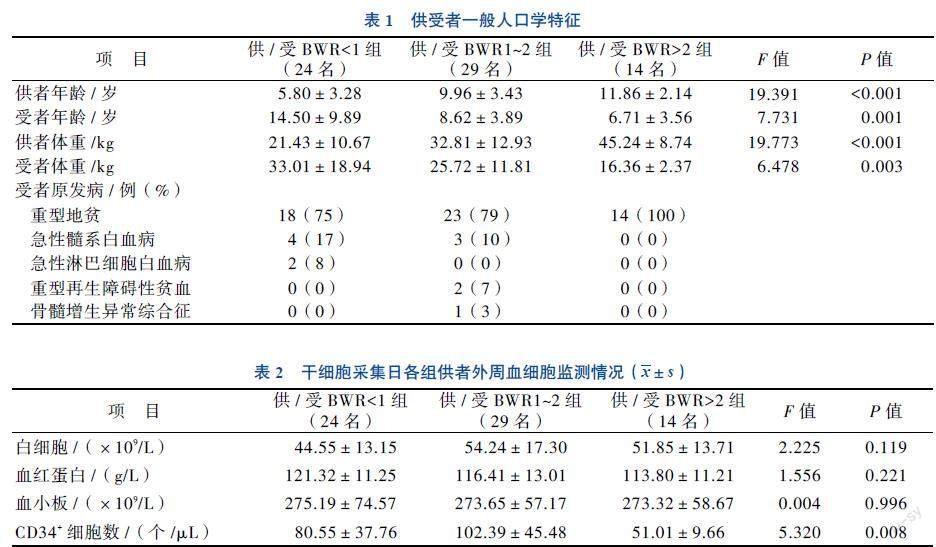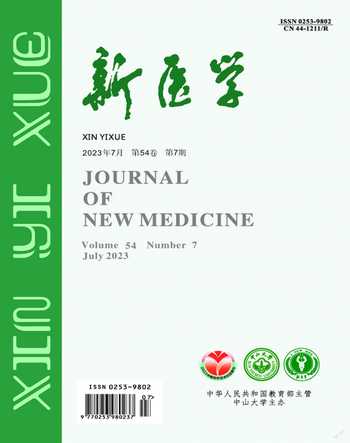67名健康儿童供者造血干细胞动员及采集效果分析
2023-07-27吴梅青陈英华刘燕晔李智刘练金施玲玲章忠明
吴梅青?陈英华?刘燕晔?李智?刘练金?施玲玲?章忠明



【摘要】目的 分析健康兒童供者的造血干细胞动员和采集效果。方法 67名健康儿童供者纳入研究,根据供/受者体重比值(供/受BWR)分为供/受BWR<1组(24例)、供/受BWR1~2组(29例)和供/受BWR>2组(14例),在各组间比较骨髓和外周血干细胞动员、采集效果、不良反应等情况。结果 供/受BWR<1的供者采集的骨髓干细胞单个核细胞数(MNC)明显低于供/受BWR1~2组和供/受BWR>2组(P均<0.001),而3组间骨髓CD34+细胞数比较差异无统计学意义(P > 0.05)。供/受BWR>2组的外周血干细胞MNC明显高于供/受BWR<1组和供/受BWR1~2组(P < 0.05),且供/受BWR>2组的外周血干细胞CD34+细胞数明显高于供/受BWR<1组(P = 0.032)。健康儿童供者动员和采集干细胞过程中不良反应可耐受,所采集的骨髓和外周血干细胞均能满足移植需求,随访其相应受者无植入不良发生。结论 健康儿童作为供者进行造血干细胞采集效果良好,采集过程安全可行。尽管低供/受BWR供者采集的干细胞比高供/受BWR供者低,但所采集的干细胞均能满足移植需求。
【关键词】儿童供者;造血干细胞动员;造血干细胞采集;安全性
Analysis of effect of hematopoietic stem cell mobilization and collection in 67 healthy pediatric donors Wu Meiqing, Chen Yinghua, Liu Yanye, Li Zhi, Liu Lianjin, Shi Lingling, Zhang Zhongming. Department of Hematology, the First Affiliated Hospital of Guangxi Medical University, Nanning 530021, China
Corresponding author, Zhang Zhongming, E-mail: zzmmissyou@126.com
【Abstract】Objective To evaluate the effect of hematopoietic stem cell mobilization and collection in healthy pediatric donors. Methods 67 healthy pediatric donors were included in this study.According to the donor/recipient (D/R) body weight ratio (BWR), they were divided into three groups: D/R BWR<1 group(n = 24), D/R BWR 1-2 group(n = 29), and D/R BWR>2 group
(n = 14). The mobilization, collection effect and adverse reactions of bone marrow and peripheral blood stem cells were compared among all groups. Results The quantity of mononuclear cells (MNCs) of bone marrow stem cells collected in the D/R BWR<1 group was significantly lower than those in the D/R BWR 1-2 and D/R BWR>2 group (both P < 0.001). There was no significant difference in the quantity of bone marrow CD34+ cells among three groups (all P > 0.05). The quantity of MNCs of peripheral blood stem cells in the D/R BWR>2 group was significantly higher than those in the D/R BWR<1 and D/R BWR 1-2 group (both P < 0.05), and the quantity of CD34+ cells of peripheral blood stem cells in the D/R BWR>2 group was significantly higher than that in the D/R BWR<1 group (P = 0.032). Adverse reactions were tolerated in all donors during stem cell mobilization and collection. The bone marrow and peripheral blood stem cells collected from pediatric donors could meet the transplantation needs. No poor implantation or implantation failure occurred in the related recipients during follow-up. Conclusions Hematopoietic stem cell collection from healthy pediatric donors is effective and safe. Although the quantity of stem cells collected in low D/R BWR is less compared to that in the high D/R BWR, the collected stem cells can meet the transplantation needs.
【Key words】Pediatric donor; Hematopoietic stem cell mobilization; Hematopoietic stem cell collection; Safety
异基因造血干细胞移植是目前治疗血液系统疾病和遗传性疾病的有效手段之一[1-3]。在重型地中海贫血(地贫)患者移植中,亲缘健康同胞通常是作为首选的供者[4]。近年来,随着单倍体移植技术的不断提高,在恶性血液病移植中,子女作为供者选择也日益增加[5]。采集足够的供者干细胞是保障造血干细胞移植成功的基本条件[6]。临床实践表明大体重儿童供者采集的干细胞通常能满足低体重受者的移植需求,而低体重供者采集的干细胞是否能满足大体重儿童或成人受者的移植需求则备受关注[7]。为评估健康儿童干细胞动员及采集效果,现将广西医科大学第一附属医院67例儿童供者的资料总结分析如下。
资料与方法
一、研究对象
2021年1月至2022年8月在本院提供造血干细胞且年龄≤14岁的健康儿童供者纳入研究。根据供/受者体重比值(供/受BWR)分为3组:供/
受BWR<1组、供/受BWR1~2组、供/受BWR > 2组。所有儿童供者的父母或监护人均签署知情同意书。本研究及流程已通过医院医学伦理委员会批准(批号:2023-E069-01) 。
二、方 法
比較各组间骨髓和外周血干细胞动员、采集效果、不良反应发生情况。
1.供者采集前准备
供者在干细胞动员和采集前完善各种相关检查:包括血常规、尿常规、粪便常规、血液生化(肝功能、肾功能、电解质、心肌酶谱等)、输血前相关检查(乙型肝炎两对半、丙型肝炎抗体、梅毒螺旋体特异性抗体、HIV抗体)、血型鉴定(ABO血型+RhD血型)、病毒相关检测(EB病毒核酸、巨细胞病毒核酸)、心电图、胸部影像学等相关检测。受者为重型地贫时,供者行地贫基因检测。
2.造血干细胞动员
采用重组人粒细胞集落刺激因子(G-CSF)5~10 μg/(kg·d)皮下注射,监测外周血细胞变化,动员第4日检测外周血CD34+细胞比例。
3.骨髓干细胞采集
体重≥30 kg的供者于动员前分次采集保存自体血,体重< 30 kg的供者根据采骨髓量(10~
20 mL/kg)于采集前配同型红细胞2~4 U备用。G-CSF动员第4日供者行骨髓干细胞采集术,手术过程严格无菌操作,术中回输预存的自体血或异体血、监测生命征,术后复查血常规、凝血功能、电解质等。
4.外周血造血干细胞采集
于动员第5日行外周血干细胞采集,外周血干细胞采集前评估供者血管情况,血管条件不佳者行股静脉置管。体重≤20 kg的供者,使用同型红细胞1 U预充管路后再行外周血干细胞分离。在采集前口服钙剂,采集过程中给予静滴葡萄糖酸钙预防低钙血症。干细胞产品经手工计数获取单个核细胞数(MNC),经流式细胞仪检测CD34+细胞数。当采集MNC或CD34+细胞数量不足时,且供者身体条件耐受情况下于动员第6日行第2次外周血干细胞采集。
5.记录干细胞动员及采集不良反应
在G-CSF动员期间、干细胞采集过程中分别记录供者出现的不良反应、持续时间、缓解方式等。干细胞采集1周后复查血常规,术后对供者的生长发育、身体健康状况、生活质量等进行长期随访。
三、统计学处理
采用SPSS 23.0统计软件进行数据分析,符合正态分布的计量资料以描述,多组间比较采用方差分析,两两比较采用LSD法进行统计学分析。计数资料用频数(%)表示,比较采用χ2检验或Fisher确切概率法。P < 0.05为差异有统计学意义。
结果
一、一般人口学特征
67名儿童供者纳入本研究,其中男30名、女37名,年龄(8.87±3.94)名,体重(31.33±14.26)kg。
供受者间均为亲缘关系,同胞之间59名、子女供父母8名,采集成功率为100%。供受者一般人口学特征见表1。
二、干细胞采集日供者外周血细胞检测
供者在干细胞采集当日的外周血白细胞、血红蛋白、血小板在3组不同供/受BWR组间比较差异均无统计学意义(P均 > 0.05)。供/受BWR 1~2组外周血CD34+细胞绝对值明显高于供/受BWR>2组(95%CI 18.961~83.798,P = 0.003)。见表2。
三、不同供/受BWR骨髓和外周血干细胞采集情况比较
67例供者中53例在动员第4日采集骨髓,所有供者均在动员第5日采集外周血干细胞,9名供者因采集MNC总数或CD34+细胞数量不足在动员第6日继续采集外周血干细胞。采集的干细胞产品MNC为(12.97±4.71)×108/ kg,CD34+细胞为
(11.51±5.05)×106/ kg。供/受BWR<1组行2次外周血干细胞采集的比例(29.2%,7/24)明显高于供/受BWR > 2组(0%,0/14),P = 0.033。供/
受BWR<1组的骨髓干细胞MNC明显低于供/受BWR1~2组(95%CI -4.373~-1.661,P < 0.001)和供/受BWR > 2组(95%CI -4.970~-1.609,P < 0.001);供/受BWR>2组的外周血干细胞MNC明显高于供/受BWR<1组(95%CI 0.999~5.676,P < 0.001)和供/受BWR1~2组(95%CI 1.439~6.049,P < 0.001),且供/受BWR>2组的外周血干细胞CD34+细胞数明显高于供/受BWR<1组(95%CI 0.225~4.798,P = 0.032)。见表3。所有供者采集的骨髓和外周血干细胞均能满足移植需求,随访其相关受者无植入不良或失败发生。
四、干细胞动员和采集过程中的不良反应
67名供者中有6名行深静脉置管,其中3名出现穿刺处疼痛,1名出现拔管后穿刺处血肿。在G-CSF动员过程中,最常见的不良反应为骨痛[25.4%(17/67)],其次为疲乏[17.9%(12/67)]、头痛[11.9%(8/67)]、恶心[9.0%(6/67)]。3组不同供/受BWR供者在动员过程中的不良反应比较差异无统计学意义(P均 > 0.05)。见表4。11.3%(6/53)供者骨髓采集后出现术口疼痛,经对症治疗后好转。在外周血干细胞采集过程中,11.9%(8/67)供者出现口周、四肢肢端感觉异常,经静脉补钙等积极对症治疗后好转,无供者因低钙血症发生抽搐。供者采集骨髓和外周血干细胞过程中不良反应耐受可,无供者因不良反应中断采集。
讨论
异基因造血干细胞移植是目前临床上治疗血液系统恶性肿瘤和非恶性疾病如血红蛋白病、骨髓衰竭综合征、免疫缺陷和先天代谢性疾病等的有效方法之一[1]。造血干细胞是通过骨髓或外周血干细胞采集从供体获得的,供者的安全性是保证干细胞移植顺利完成的前提条件。近年来,随着生育政策的调整和单倍体移植技术的不断提高,儿童亲缘同胞和未成年子女作为干细胞供者日益增多[8-9]。由于年龄小、体重轻及独特的生理机能,与成人相比,儿童在干细胞采集过程中可能会面临各种困难,如血管通路、体外循环容积和血流速度等问题[10-11]。大龄大体重的儿童供者采集的干细胞通常能满足低龄低体重受者的移植需求,然而,在临床实践中通常需要面临低龄低体重供者干细胞的采集,这部分供者的干细胞能否满足大龄大体重同胞或成人父母受者的移植需求则备受关注。
Truong等[6]学者曾报道在199名儿童中,35名健康同胞供者外周干细胞采集成功率为100%,在164名儿童患者自体外周血干细胞采集成功率为93%。Díaz等[12]和Suzuya等[13]学者曾分别报道供者年龄是影响外周血干细胞产品采集的重要因素。一项纳入201例儿童供者的多中心回顾性研究也显示相比于大龄的儿童供者,年龄小于6岁的供者可以采集到更高的CD34+细胞产品[14]。在临床实践中,低龄低体重儿童作为供者采集的干细胞能否满足大体重受者的移植需求尚未明确。本研究中,67名健康亲缘儿童供者纳入分析,同胞之间59名、子女供父母8名。采集的干细胞产品MNC为(12.97±4.71)×108/ kg,CD34+细胞为(11.51±
5.05)×106/ kg,采集成功率为100%。本研究以供/
受BWR对儿童供者进行分组分析,结果显示与供/
受BWR>2组相比较,供/受BWR<1组供者的干细胞产品总MNC和CD34+细胞数均明显降低,因此,供/受BWR<1组供者行2次外周血干细胞采集的比例明显升高。然而,供/受BWR<1组供者骨髓联合外周血干细胞产品MNC和CD34+细胞数
分别为(10.57±3.23)×108/kg和(9.30±4.08)×
106/kg,亦能满足受者移植需求。所有供者采集的造血干细胞均能满足移植需求,随访其相关受者无植入延迟等不良情况发生。
G-CSF是目前临床上常用的造血干细胞动员剂,既往文献报道健康供者使用G-CSF动员最常见的不良反应为骨痛[15-17]。本研究中,儿童供者使用G-CSF动员过程中最常见的不良反应也为骨痛,发生率为25.4%,与既往文献报道相一致。在干细胞采集过程中,由于使用枸橼酸抗凝剂,供者通常因体内钙离子被螯合后出现低钙血症,最常见为口唇及四肢麻木,恶心、呕吐,心悸、手足抽搐,严重者可发生心律失常等[18]。本中心在采集前常规给予供者口服补钙,采集过程中动态给予静脉滴注葡萄糖酸钙,本组健康儿童供者采集过程中口周及四肢感觉异常的总体发生率为11.9%,经静脉补钙等积极治疗后好转,无供者因低钙血症发生抽搐。此外,我们还观察到年龄越小的供者越容易出现低钙表现,需提前补充钙剂预防,并在采集过程中密切关注供者情况。本研究中的供者均能良好耐受干细胞动员和采集,无供者因不良反应而中断采集。
综上所述,儿童健康供者进行骨髓和外周血干细胞采集效果良好,采集过程安全可行。尽管低供/受BWR儿童供者采集的干细胞比高供/受BWR供者低,但所采集的干细胞均能满足移植需求,无受者发生植入不良。干细胞动员前进行全面的评估,采集过程仔细观察,采集后定期随访对保证儿童供者安全有重要意义。
参 考 文 献
[1] 王昱, 黄晓军. 造血干细胞移植在血液疾病中的应用进展. 中华血液学杂志, 2019, 40(8): 704-708.
[2] Qin F, Shi L, Li Q, et al. Immune recovery after in vivo T-cell depletion myeloablative conditioning hematopoietic stem cell transplantation in severe beta-thalassemia children. Eur J Haematol, 2019, 103(4): 342-350.
[3] 阙丽萍, 徐宏贵, 詹丽萍, 等. 免疫治療桥接二次非血缘外周血干细胞移植治疗重型β地中海贫血一例. 新医学, 2021, 52(8): 637-640.
[4] Li Q, Luo J, Zhang Z,et al. G-CSF-mobilized blood and bone marrow grafts as the source of stem cells for HLA-identical sibling transplantation in patients with thalassemia major. Biol Blood Marrow Transplant, 2019, 25(10): 2040-2044.
[5] Wang Y, Wu D P, Liu Q F, et al. Donor and recipient age, gender and ABO incompatibility regardless of donor source: validated criteria for donor selection for haematopoietic transplants. Leukemia, 2018, 32(2): 492-498.
[6] Truong T H, Prokopishyn N L, Luu H, et al. Predictive factors for successful peripheral blood stem cell mobilization and collection in children. J Clin Apher, 2019, 34(5): 598-606.
[7] Sevilla J, Díaz M A, Fernández-Plaza S, et al. Risks and methods for peripheral blood progenitor cell collection in small children. Transfus Apher Sci, 2004, 31(3): 221-231.
[8] Orbach D, Hojjat-Assari S, Doz F, et al. Peripheral blood stem cell collection in 24 low-weight infants: experience of a single centre. Bone Marrow Transplant, 2003, 31(3): 171-174.
[9] Karasu G, Uygun V, Yesilipek A. Factors associated with peripheral blood stem cell yield in healthy pediatric donors. Transfus Apher Sci, 2017, 56(6): 819-824.
[10] Sharma N, Sawant R B, Sen S. Optimizing pediatric peripheral blood stem cell collection. Transfus Apher Sci, 2021, 60(1): 102966.
[11] Benakli M, Ahmed Nacer R, Mehdid F, et al. Peripheral blood stem cell mobilization and collection in pediatric healthy sibling donors weighing 20 kilograms or less; Algerian experience. Transfus Apher Sci, 2020, 59(6): 102987.
[12] Díaz M A, Sevilla J, de la Rubia J, et al. Factors predicting peripheral blood progenitor cell collection from pediatric donors for allogeneic transplantation. Haematologica, 2003, 88(8): 919-922.
[13] Suzuya H, Watanabe T, Nakagawa R, et al. Factors associated with granulocyte colony-stimulating factor-induced peripheral blood stem cell yield in healthy donors. Vox Sang, 2005, 89 (4): 229-235.
[14] Pulsipher M A, Levine J E, Hayashi R J, et al. Safety and efficacy of allogeneic PBSC collection in normal pediatric donors: the pediatric blood and marrow transplant consortium experience(PBMTC) 1996-2003. Bone Marrow Transplant, 2005, 35(4): 361-367.
[15] 梁赜隐, 任汉云. 重组人G-CSF对健康供者外周造血干/祖细胞动员和采集效果的影响因素分析. 中国实验血液学杂志, 2008, 16(4): 847-851.
[16] Karakukcu M, Unal E. Stem cell mobilization and collection from pediatric patients and healthy children. Transfus Apher Sci, 2015, 53(1): 17-22.
[17] Murata M, Harada M, Kato S, et al. Peripheral blood stem cell mobilization and apheresis: analysis of adverse events in 94 normal donors. Bone Marrow Transplant, 1999, 24(10): 1065-1071.
[18] 張伸, 金辉, 许兰平, 等. 亲缘与非亲缘供者造血干细胞动员和采集的安全性比较. 中国实验血液学杂志, 2010, 18(4): 1017-1022.
(收稿日期:2023-03-25)
(本文编辑:杨江瑜)
